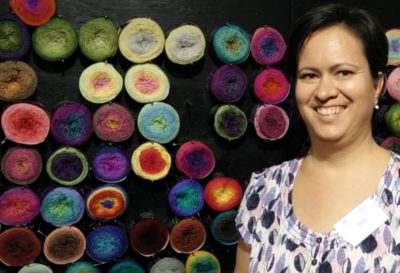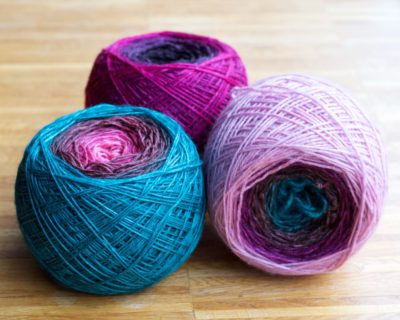Strickmich! Club 2017: Bilum

|

|
… and here she is, our third dyer for Strickmich! Club 2017: Zsofi Csongor and her insanely beautiful handdyed gradient Bilum yarns. They are truly special, as producing yarns with long color changes by hand is a very elaborate process. “When I saw a picture of such a yarn I instantly fell in love with it”, Zsofi says, “so I started experimenting. It took me quite a long time to figure out how to do it, but I did develop my own method to dye long, harmonious color changes.” When I saw Zsofis yarns at Edinyarnfest, I fell in love with them – I had never seen yarns like this on such beautiful yarn bases. Needless to say that I am especially happy that we will be able to have one of Zsofi’s creations in Strickmich! Club 2017. I am really looking forward to designing with it!
I had often seen yarns with long color changes in a cotton/acrylic blend, and they are usually made by having a number of threads in one color next to each other, and one after another is cut and joined with a thread in another color with a knot. These yarns are usually not plied. In contrast to that, Bilum yarns are readily spun luxurious yarns and they are dyed by hand using Zsofi’s very own method.

My Bilum yarns from Edinburgh
Zsofi lives and works in Budapest, Hungary and started dyeing yarn about five years ago. “I have always liked to work creatively with my hands, as a kid I loved painting textiles like silk, sewing, knitting and so forth”, she says. “When I stayed home with my third child, I found I had time to try something new. I found handdyed yarns on the internet and immediately wanted to try dyeing wool myself.” She started out with food colors but quickly changed to acid dyes as they can be mixed more easily to achieve the desired colorway. “To me it is extremely important to use all-natural yarn bases, and they have to be the highest quality”, Zsofi says. She is a declared fan of luxurious fibers and loves to knit with her “Muli” (a silk-and-camel blend) and “Muruk” (yak and silk) yarns. “My favorite color is red, always has been”, she says. When she finds the timer, she likes to cook and bake and try out new crafting techniques. In Budapest, knitting has become a big trend: “There are lots of yarn shops here and many young people have taken up knitting, some of them with handdyed yarns. Sometimes I see my yarns knit up, and that’s just so wonderful!”
Zsofi offers her yarns in her online store, on Etsy, but also at wool festivals all over Europe, including Zurich, Hamburg, Edinburgh, Vienna and Berlin.
sondern auch auf Wollmärkten in Zürich, Hamburg, Edinburgh, Wien oder Berlin. Will we be able to lure her to come to our Cast-on Event here in Damsdorf? Let’s see, a little surprise shall remain…
P. S. If you were asking yourself what “Bilum” means – it is a traditional crafted bag from Papua New Guinea, where Zsofi has lived for one and a half years, so she chose this name for her brand. The yarns themselves also have words from the “Tok Pisin”-language spoken there as their namas: “Pukpuk” means crocodile, “Pikinini” means child and so on.






Wow super schöne Garne!! Hoffentlich verpasse ich die Anmeldung nicht.
Liebe Grüße Sabine
Oh, klasse! Darauf freue ich mich schon.
Lange, sanfte Verläufe gefallen mir ganz besonders, aber bei gefachten Garnen habe ich oft das Problem, daß ich immer extra langsam stricken muß, um auch wirklich alle Einzelfäden mit zu erwischen, und dann sind sie ja meistens auch insgesamt etwas dicker.